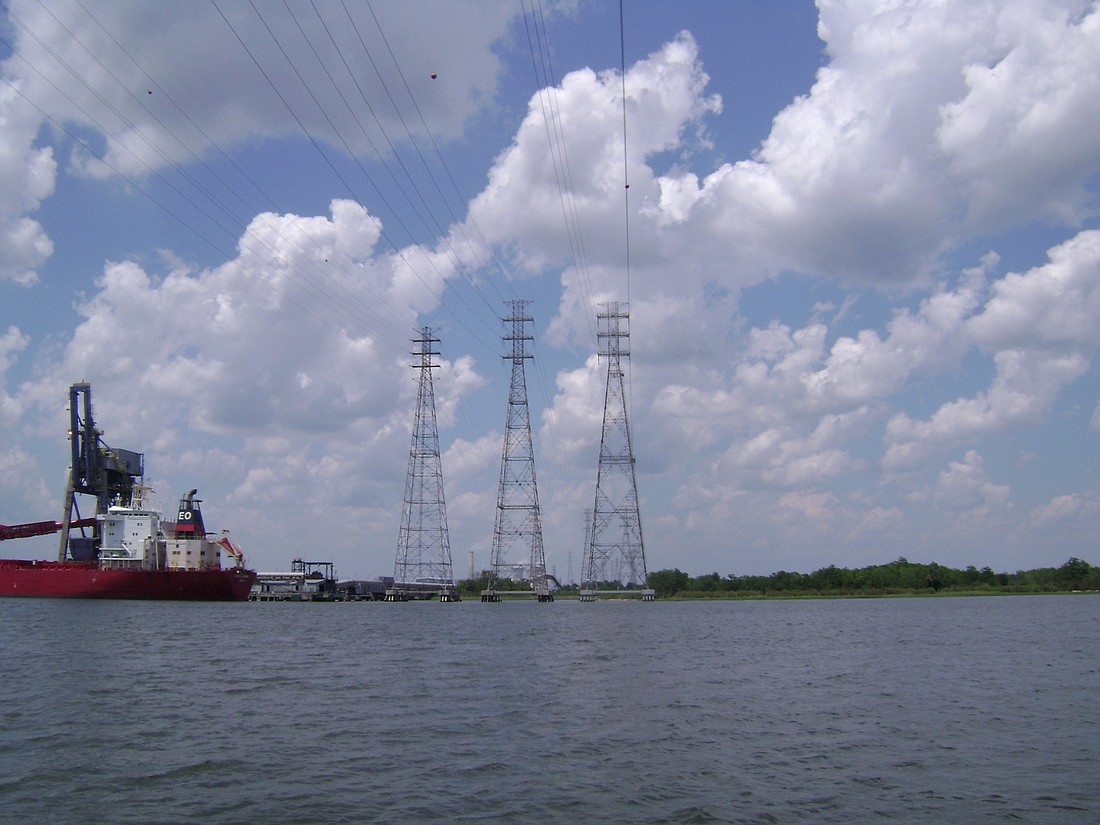
The Jacksonville Port Authority agreed to pay what could be $54.4 million for JEA to raise six high-voltage transmission lines over the St. Johns River to give additional clearance to large ships coming into the Blount Island Marine Terminal.
JaxPort will secure 100% of the funding to raise the Fulton Cut Crossing transmission lines near Blount Island, according to a memorandum of understanding with JEA approved June 27 by the JaxPort board.
JaxPort officials expect the project to be completed in 2026, according a timeline in the June 27 board materials.
The two authorities have been negotiating who would pay to raise the power lines for more than a year.
In December 2020, JaxPort and St. Johns Bar Pilot Association conducted a simulation that found large ships would need a minimum 197 feet of clearance to safely navigate under the power lines.
The current lines, installed in 1982, have 175 feet of clearance.
In May, JaxPort completed a four-year, $420 million harbor deepening project, working with the U.S. Army Corps of Engineers to dredge the 11-mile federal shipping channel in the St. Johns River to 47 feet to allow passage of large, post-Panamax vessels.
Post-Panamax ships are large vessels that can pass through the enlarged Panama Canal.
The city-owned JEA utility completed and released a feasibility study in May by engineering services company Worley that showed an estimated cost of $33.49 million to $54.42 million to raise the lines.
In the memorandum of understanding, JaxPort is using JEA’s median estimate of about $42 million as a working number.
On March 4, JaxPort board member Jamie Shelton sent a letter to Gov. Ron DeSantis urging JEA to move faster on a plan to raise the power lines.
“Time is not on our side,” Shelton wrote.
“The continued failure of JEA to immediately begin the process of raising the power lines will place JAXPORT and the State of Florida at a disadvantage in attracting new vessel services, especially as we compete with Charleston and Savannah.
“Not to mention negatively impacting the return on investment made by the State for the harbor deepening project, which would not have been possible without your continued support,” he wrote.
That was followed by a March 30 letter to JEA CEO Jay Stowe asking for an update on the utility’s plan to ensure the power lines were raised.
JEA officials and the city Office of General Counsel helped negotiate the memorandum of understanding, according to JaxPort Chief of Regulatory Compliance Nick Primrose.
JEA board member John Baker, who was JaxPort board chair in 2019, said April 5 he supported raising the lines.
“(The) ships are getting bigger and the dredging that’s going on at the port would literally be wasted if the lines were not raised,” Baker said.
At that April meeting, before the utility obtained a final cost estimate, Baker said the price to raise the lines may be $30 million, “but it’s way more than that in terms of risk and reliability of our (electric) system.”
“I think Jay (Stowe) has been very steadfast and direct in saying JEA’s ratepayers should not be paying for it. There are others that can, whether it’s the city, whether it’s JPA (JaxPort), whether it’s the federal government,” Baker said April 5.
“That’s fine. But we are taking a huge risk by moving these power lines — raising them. Half our people are relying on those power lines,” he said.
The JEA and JaxPort boards must finalize and approve an interlocal agreement for the port to pay for the utility’s work.
“JEA is focused on how to best serve the growing needs of Northeast Florida and help drive economic growth in the region,” Stowe said in an email June 27.
“This project will allow for larger ships and thus provide for more jobs and economic growth in Northeast Florida.”
JaxPort included a $30 million “power lines” line item in its proposed fiscal year 2023 capital projects budget the board unanimously approved June 27.
The expense comes during a year JaxPort officials expect a decline in revenue.
The financial forecast in the port budget presented by JaxPort CFO Beth McCague shows about $58.87 million in revenue next year compared with $61.06 million in 2019 before the pandemic.
McCague says JaxPort likely will see an increase in cargo tonnage from 2022 but not as high as 2019 numbers.
The budget, which includes the power line item, will have to be submitted and approved by City Council. That budget vote historically happens in September.